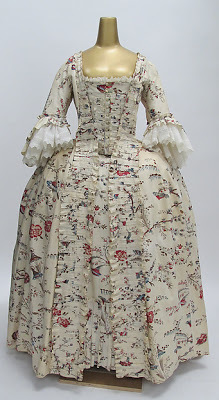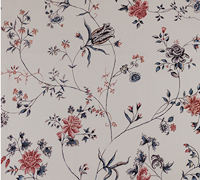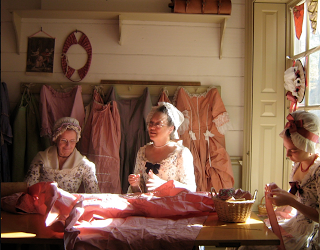Watch the Mantua-Makers Create a c1774 Dress in a Day
 Isabella reporting,
Isabella reporting,Today is the longest day of the year. If you're an 18thc seamstress whose workday is determined by the light of the sun, it's a rare opportunity to make an entire dress in a day.
At least that's what will be happening today in the Margaret Hunter shop in Colonial Williamsburg . Beginning at 7:00 am and ending around 6:00 pm, a length of lovely printed cotton chintz will be transformed into a gown and petticoat much like robe à la française, left. The seven women with the flying needles will be Janea Whitacre, mistress of the trade; Sarah Woodyard, journeywoman; Abby Cox, apprentice (all part of the Historic Trades program at Colonial Williamsburg); Rebecca Starkins, Adi Harris, and Kaila Temple, summer interns in the shop; and Norah Worthington, resident costumer at the Baltimore School for the Arts, who will participate as part of a professional development exchange program.
Anyone in town with a Colonial Williamsburg pass will be able to visit the shop today and watch. For the rest of us, the dress's progress will be shown today on the Historic Trades Facebook page here . I'm told there will be streaming video as well as still photographs to show each step of pinning, cutting, and stitching to create the finished gown by the end of the day. Everything will be done entirely by hand, as it would have been done in the 18thc. (Just keep in mind that all this will be happening in Virginia time, in the Eastern time zone.)

For those of you interested in sewing along at home (you know who you are), Colonial Williamsburg is also offering this cotton chintz, right, exclusively on their website. It's a reproduction of an 18thc textile in their collection; for more information or to order, see here .
While making a dress in a day sounds like a grand-standing slogan, it wasn't that uncommon in the Georgian era. If a lady wanted a new gown to wear the day after tomorrow and had the money to pay for it, a mantua-maker and her seamstresses would be happy enough to oblige.

While suitable for drinking tea, calling on friends, visiting shops, or attending church, a gown and petticoat like this one wouldn't come cheaply. This is clothing for a wealthy, fashionable woman, or perhaps a successful woman working in the fashion trade who needs to impress her customers. Imported from India, cotton chintz printed in multiple colors was a luxury fabric, and could cost ten to fifteen shillings a yard, with a gown like this one requiring about ten yards of fabric.
By comparison, the cost of labor would only be about ten shillings. Labor was cheap in the 18thc, and that charge of ten shillings would be a set price, the same whether one seamstress worked for three days, or seven worked for one. The total dress could cost roughly £5-£8. The wages for a common seamstress? One-and-a-half shillings for a twelve hour day.
You can also watch a vodcast of the Colonial Williamsburg mantua-makers create a previous dress in a day: part one and part two .
Top left: Robe à la française, French, 1760s, Metropolitan Museum of Art.
Bottom left: Photograph of Margaret Hunter Shop © Susan Holloway Scott.
Published on June 20, 2016 21:00
No comments have been added yet.



